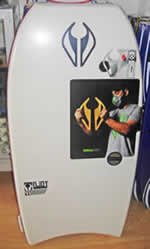How to choose a Bodyboard
Bodyboarding is really easy to start, a bodyboard suited to your weight and height (see chart under), a good pair of fins (flippers) and a leash will have you on the way to catching your first wave, pulling a 360 even on the flat section is another story....
Bodyboard | Your weight | Your height |
|---|---|---|
36"-38" | 65 - 85 lbs | 4' - 5' |
39" | 85 - 115 lbs | 4'6" - 5'2" |
40" | 110 - 130 lbs | 5'3"- 5'6" |
41"- 41.75" | 125 - 170 lbs | 5'7" - 5'9" |
42" | 145 - 180 lbs | 5'9"-6'0" |
42.5" | 160 - 190 lbs | 5'10"- 6'2" |
43" | 170 - 210 lbs | 6'1"- 6'3" |
44" | 180 - 270 lbs | 6'2"- 6'4" |
45" | 195 - 255lbs | 6'3" - 6'6" |
46" | 200lbs + | 6'4" + |
Length- Your board, when standing on it's tail should come up to roughly within 1 inch either side of your belly button.
Width- You should be able to hold the bodyboard under your arm and against your side without much slack between your armpit and the rail.
Nose and tail width, and template- if you're a beginner, the tail design doesn't really matter much. but if you're more into the sport, bat tails are the choice of most prone-only riders, and crescents are the choice of most drop knee-only riders. If you are both, then consider what your ratio of prone to drop knee is, and go with the tail design that covers how you ride more (prone or drop knee). On templates, most prone riders like a bodyboard with the wide point closer to the nose, and most drop knee riders like it further back.
Rails- Most bodyboards have a 60/40 rail configuration that means that 60% of the rail is on the bottom side and 40% is on top, this is better for prone riding and makes tricks easier to pull off . Some bodyboards have a 50/50 rail which sticks better to the curl , it is also more stable ( good for Drop Knee riding) but less forgiving for the 360 and reverse tricks.

No comments:
Post a Comment